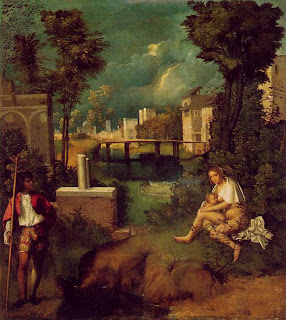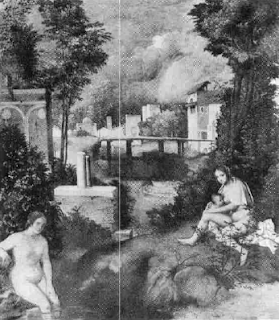Thursday, August 5th, 2010
Giorgione’s Gypsy?
 Recently I have been reading some back-and-forth discussion on Three Pipe Problem regarding interpretations of Giorgione’s Tempest (c. 1505, shown right). Whenever I teach this painting to students, I give some background on the extant interpretations and scholarship, but I have never promoted one theory above another. The reason? In my opinion, it’s just too hard. I haven’t found one interpretation that completely satisfies all of my questions regarding the enigmatic subject matter and composition.
Recently I have been reading some back-and-forth discussion on Three Pipe Problem regarding interpretations of Giorgione’s Tempest (c. 1505, shown right). Whenever I teach this painting to students, I give some background on the extant interpretations and scholarship, but I have never promoted one theory above another. The reason? In my opinion, it’s just too hard. I haven’t found one interpretation that completely satisfies all of my questions regarding the enigmatic subject matter and composition.
One of the more popular arguments is that this painting is a Flight into Egypt scene, although that argument still leaves me with some questions. X-ray scans of the painting reveal that Giorgione first painted a woman on the left side of the painting (see below, as reconstructed by Morassi in 1939), and then later changed his mind and painted the woman on the right (which is why both women appear in the x-ray scan. For someone who is familiar with the final painting, this scan almost seems creepy at first glance, since the male figure eerily nonexistent.).
Anyhow, the woman revealed through x-ray is not holding an infant, nor is she positioned so that an infant could have been painted in her arms afterward. This suggests to me that the female figure was not initially intended to be a Madonna (at least for a Flight of Egypt scene, since Mary is always depicted as the one holding the Christ Child). Giorgione obviously could have changed his mind afterward in regards to the subject matter, but this initial female figure makes me wonder if the painting was intended to be (and still is) secular in nature.
I am especially intrigued by Paul Holberton’s argument that the woman in the painting is a gypsy.1 Holberton’s article, “Giorgione’s ‘Tempest’ or ‘little landscape with the storm with the gypsy’: more on the gypsy, and a reassesment” discusses the clothing and iconography for gypsy women, and also gives some great examples of gypsies in the art of Giorgione’s contemporaries. I think there are some interesting ideas presented, and I can see how both the man and woman can be interpreted as gypsies. However, I have to admit that I don’t agree with everything Holberton suggests (e.g. I don’t think that the two figures seem “united by a bond of love.” They are too far separated across the canvas to fully suggest that idea to me).1
Do you latch onto a certain interpretation of Giorgione’s Tempest? Why?
1 Paul Holberton, “Giorgione’s ‘Tempest’ or ‘little landscape with the storm with the gypsy’: more on the gypsy, and a reassesment,” Art History 18, no. 3 (September 1995). Available online here. Holberton isn’t the first person to put forth the gypsy argument, but I like much of the logic and ideas that he presents. I also like that Holberton discusses a little bit of the historiography of the Tempest, which makes this article a useful resource for scholars.
2 Ibid. Available online here (p. 14).

Not really. I have to admit this is one of the paintings that frustrates me because no one knows what it's about, and it could really be about anything. Plus, to me the left and right sides of the painting seem completely divided, like they're two paintings smooshed together.
I saw this painting when I went to Venice a few years ago! It was pretty cool. Even more mysterious in person. 😉
Cheers for the mention M!
I think Giorgione's mysterious Castelfranco Frieze is perfect evidence of his fondness for conundrums.
I'm sure he would be delighted to know that he was still confounding us 500 years into the future.
He really is a magical character of the Renaissance. If Leonardo can meet you as a young man and think you charming and witty, then there has to be something special there!
H
I hope you that in the future you will include the "Rest on the Flight into Egypt" as one of the possible subjects. If your students even consider the possibility of a sacred subject in the Tempesta, they might then be able to see the "Laura" as Mary Magdalen; the "Three Philosophers" as the Magi; and the "Boy with an Arrow" as St. Sebastian.
I would have to agree with Heidnekind. Every time I look at this painting I can never quite make complete sense of it. It has always struck me as, well, almost a little unnerving/strange/oddly compelling/weird/two paintings in one/awkward/interesting?
Also, I would have to agree with you on the "love bond." I don't really see it.
Thanks for the comments, everyone! Dr. F, I appreciate you visiting my site from the link I left at 3PP. The Flight into Egypt theory is one of the arguments that I present to my students. Although I have misgivings about the interpretation, I want my students to formulate their own opinion regarding the theory. And thank you for leaving a link to your "La Tempesta" paper in the 3PP comment section. I'm including the link here, in case other readers might like to see your stance. You have interesting ideas as to why the Madonna is nude.
I agree with H Niyazi: Giorgione had an apparent fondness for visual conundrums!
I think it's meant to be unnerving and mysterious — like a storm itself.
I always thought maybe it was a rendering of the end of the world, with the half-clothed woman nursing a child as a reference to the scripture "Woe be unto those who give suck in those days" (or something along those lines). But that doesn't really explain what the clothed man is doing on the other side of the image.
They really seem cut off from one another and lost in their own thoughts.
I just had another thought – it's interesting that Giorgione kept placing clothed men and naked women in the same image together, like in the Pastoral Concert.
Do you think it says something about the clothed male artist in the studio vs. the nude female model?
The relationship between nude and clothed figures in the same Renaissance painting is discussed in my paper on the Tempesta which M has provided a link to above. The nude figure represents a higher order of being.
Also, in the blog section of my website I refer to Leo Steinberg's ground breaking work on the nude Christ in Renaissance art.Just search for Steinberg in the Blog section.
I think your clothed artist vs. nude model idea is interesting, Char. (I seem to remember Martha making some similar comment in her lectures about "Pastoral Concert.") I wonder if a feminist writer has picked up on that interpretation. Giorgione is mentioned a couple of times in "The Expanding Discourse: Feminism and Art History" (see here if you are interested), but there's nothing along those lines in that publication.
And thank you for pointing out where to find that aspect of your argument, Dr. F!
I know that you've followed my conversation with H on the Tempesta and the Rest on the flight into Egypt. He asked for an explanation of the bird on the rooftop in the background, and I believe I've found the source in Psalm 101. I've just posted a discussion on my Giorgione Tempesta website.
F
Very interesting argument regarding the bird, Frank. That's supports your argument quite well, especially the whole connection with the desert/Egypt/Nile. What a great connection for you! (For anyone who is interested, you will notice that there is a small bird sitting on the roof in the background of "The Tempest.") You can read Frank's blog post here.
Thanks for the link to my website, and thanks for the kind words about my Tempesta interpretation.
Today, in the blog section of my website I argue that Giorgione's so-called Three Ages of Man in the Pitti Palace is actually a depiction of a famous incident from the gospel of Matthew. It is Jesus, Peter, and the young man of great wealth.
I wonder what you think.
Frank